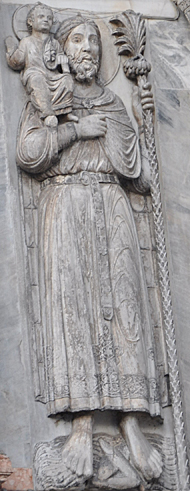But it is the 13th-century Golden Legend that determines the portrayals of Christopher in western art. Here the saint begins as a gigantic pagan named Reprobus ("the reject") who desires to serve whoever is the most powerful of kings. His first king appears to be afraid of the devil, so Reprobus reasons that the devil must be stronger and seeks him out. But the devil proves to be terrified by a wayside crucifix, so Reprobus abandons him and seeks the man on the Cross. A hermit teaches him about Christ, baptizes him as Christophoros, "Christ bearer," and says he should serve the Lord by carrying people across an otherwise unfordable river.
One day Christopher takes a small child on his shoulders, who grows heavier and heavier as they cross the stream. The child explains, "thou hast not only borne all the world upon thee, but thou hast borne him that created and made all the world, upon thy shoulders." He is the Christ Child. He tells Christopher to plant his staff in the ground today and it will bear leaf and fruit tomorrow. The miraculous staff later enables him to convert thousands of pagans in Lycia. At this, the king of Lycia orders him put to death.
Images of the saint crossing the river with the Christ Child on his shoulders came to be extremely common in western art from the 13th century until modern times. As at right, most images have the staff already in leaf, an orb in the child's hand, and fish in the river. Some images also put the hermit on the bank of the river (example). Otherwise, the variations are few. In some, we may see the staff replaced by a palm branch (example) or an entire palm tree (as in the second picture at right). A painting in Dresden's Gemäldegalerie by the Master of the Embroidered Foliage places images of God the Father and the dove as Holy Spirit above the child, who holds a cross-standard of the kind seen in Resurrections (One Hundred Saints, 70).
Pilgrims who looked upon an image of St. Christopher were believed to gain a special blessing, so many medieval and later churches put up huge images that no pilgrim could miss, either on a prominent interior wall (example) or on the outside of the building, as this mosaic in Germany.1 In 1594 Molanus condemned this belief as superstitious, but it appears to have endured.2 The Glottertal image, for example, was added to the exterior wall only in 1907.3
The staff and the child are retained even in group images where the river cannot be shown, as in images of the 14 Holy Helpers. Very rarely we see the saint with just his staff, as in this painting with the saints in Heaven or possibly this image of the Doge at prayer.
Narrative images are also rare. There is a miniature of the episode with the devil and the crucifix in Jean Poyet's Hours of Henry VIII (Wieck, 149). One French church has a narrative cycle in stained glass based on the Golden Legend. And there is A Russian icon that illustrates a quite different legend.
Christopher images almost always portray the saint bare-headed, but in a wall painting in England he wears what looks like a pilgrim's hat with the brim turned down.
Statuettes of St. Christopher with staff and child graced thousands of American dashboards in the mid-twentieth century, as he was the patron saint of travelers. But when the Vatican removed him from the church calendar in 1969, it was widely (and wrongly) assumed that he had been declared not a saint, and the practice declined.4
Prepared in 2014 by Richard Stracke, Emeritus Professor of English, Augusta University, revised 2015-10-19, 2016-09-30.
HOME PAGE

This is the typical image of St. Christopher carrying the Christ Child across the river. Note the fish swimming in the water and the globe in the child's hand. (See the description page)

In this relief in Padua Christopher's staff is made to look like an entire palm tree with fruit. The fish are more visible than in the painting above, and the globe has been replaced by a scroll in the child's left hand. (See the description page)
MORE IMAGES
- 1425: A very faint fresco in Croatia.
- 1425-50: Statuette
- 1500-1504: St. Christopher is in this statuary group from Riemenschneider's set of portraits of the Fourteen Holy Helpers.
- 1500-1510: A stained glass image of St. Christopher's river crossing with the saint's commendation of the donor, a knight.
- 19th century: A bulto of St. Christopher from New Mexico.
DATES
- St. Christopher's feast day, July 25, is no longer observed in the Roman Catholic Church.
BIOGRAPHY
- Golden Legend #100: html or pdf
- Passion of St. Christopher (BHL 1764)
- The Irish Passion of St. Christopher
- The verse life from the South English Legendary: Original Middle English in Horstman, 271-78, translation in Stouck, 568-78.
- Acta Sanctorum, July vol. 6, 125-149
- "Sancti Christophori Martyris Acta Graeca Antiqua," in Analecta Bollandiana, I, 121-48.
- Carolus de Smedt, Josephus de Backer, Franciscus van Ortroy, Josephus van den Gheyn, edd. "Passio S. Christophori, Martyris," Analecta Bollandiana, X, 393-405.
NOTES
1 Butler, III, 187.
2 Molanus, III, xxvii, 317-18.
3 Kath. Pfarrkirche St. Blasius (guide sold in the church in Glottertal).
4 See "Did the Church declare that St. Christopher is a myth?"